MSI K8N Neo Platinum: First nForce3-250Gb
by Wesley Fink on April 26, 2004 12:05 AM EST- Posted in
- Motherboards
Basic Features: MSI K8N Neo Platinum
| Motherboard Specifications | |
| CPU Interface | Socket 754 Athlon 64 |
| Chipset | nVidia nForce3-250Gb |
| Bus Speeds | 200MHz to 300MHz (in 1MHz increments) |
| PCI/AGP Speeds | Auto, 66MHz to 100MHz (in 1MHz increments) |
| Core Voltage | Default to 1.81V in % increments (with 1.50V, 1.57V, 1.60V, 1.65V, 1.68V, 1.73V, 1.76V, 1.81V) |
| DRAM Voltage | Auto, 2.5V to 2.85V in 0.05V increments |
| AGP Voltage | 1.5V-1.85V in 0.05V increments |
| AUTO Overclock | D.O.T. Ranger, 1%, 3%, 5%, 7%, 9%, 11% |
| Memory Slots | Three 184-pin DDR DIMM Slots Unbuffered Non-ECC Memory to 2GB Total |
| Expansion Slots | 1 AGP 8X Slot 5 PCI Slots |
| Onboard SATA/IDE RAID | nVidia 4-Drive SATA Plus 4-Drive IDE IDE/SATA can be combined in 0, 1, 0+1 |
| Onboard IDE | Two Standard nVidia ATA133/100/66 (4 drives) |
| Onboard USB 2.0/IEEE-1394 | 8 USB 2.0 ports supported by nF3-250 2 1394A FireWire ports by VIA VT630 |
| Onboard LAN | Gigabit Ethernet on-chip by nF3-250GB |
| Onboard Audio | Realtek ALC850 8-Channel with UAJ |
| BIOS Revision | 1.13 (4/15/04) |
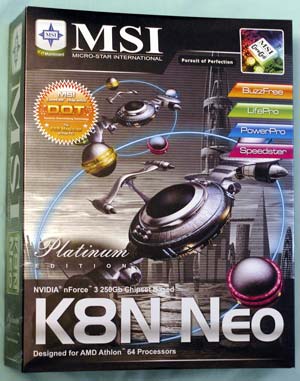
You should have no trouble finding the black-on-foil K8N Neo package on dealer's shelves. While the package is not as flashy as past MSI boards, the Platinum series still stands out.

Several manufacturers have been paying more attention lately to the internal protection and presentation of motherboards. MSI uses 2 internal packages; one for the accessories and manuals, and one for the motherboard itself.

MSI includes red-wrapped IDE and floppy cables, and orange SATA cables. Against the black K8N Neo, these will certainly stand out. A molex power converter is included for 2 SATA drives. Additional brackets are in the box for 2 additional USB Ports combined with MSI's trademark 4-LED diagnostics, and for standard and mini Firewire.
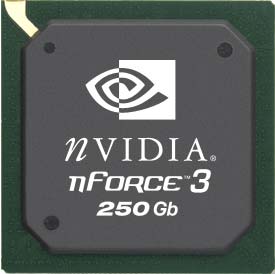
The single chip nVidia nForce3-250Gb is used for K8N Neo Platinum. For more information on this chipset, you can refer to our launch articles for this new chipset:
nForce3-250 - Part 2: Taking Athlon 64 to the Next Level
nForce3-250 - Part 1: Taking Athlon 64 to the Next Level
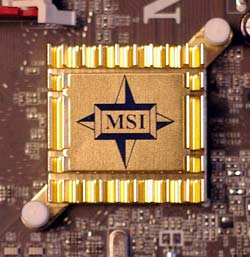
MSI used only a passive heatsink on the K8N Neo. We found that the heatsink got very hot after running for a few hours, particularly during overclocking. We would recommend that those planning to overclock or heavily load the K8N Neo replace the passive heatsink with an active heatsink and fan. Fortunately, standard mounting holes are provided and there are spare fan connectors nearby. The K8N Neo never crashed from the heat, but better cooling is likely needed.
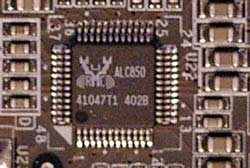
This is the first board that we have tested to use the Realtek ALC850 7.1 audio chip. This 8-channel audio codec is fully AC '97 2.3 compliant and features 16-bit 8-channel audio and auto-jack sensing with support for a full range of analog and digital IO. A wide range of sound standards are supported, including:
- EAXTM 1.0 & 2.0 compatible
- Direct Sound 3DTM compatible
- A3DTM compatible
- I3DL2 compatible
- HRTF 3D positional audio
- SensauraTM 3D Enhancement
You can find more details on the recently released ALC850 at Realtek product information.

The ALC650 is complemented by 5 audio mini-jacks plus both Optical and coaxial SPDIF connectors on the back IO panel. IO also includes PS2 mouse and keyboard, parallel, 1 serial, 1 standard Firewire (IEEE1394), 4 USB, and a Gigabit Ethernet port. MSI has provided an exceptional array of IO options on the M8N Neo Platinum, and buyers will generally be pleased with the provided options.
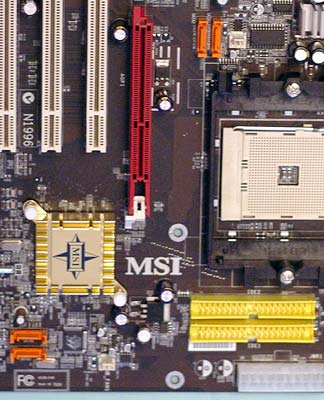
The K8N Neo fully supports the innovative nVidia "Any Drive" RAID. Any of the standard 4 IDE drives or an additional 4 SATA drives can be combined in a Raid 0 (striping), Raid 1 (Mirroring), or Raid 0+1 array. This is the most flexible RAID arrangement that we have seen built into any chipset.
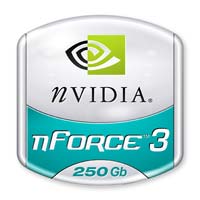
On-chip Gigabit LAN is built-in with the nF3-250Gb and runs completely independent of the PCI bus. This ensures that the LAN is always capable of providing the fastest throughput possible with your LAN connections.
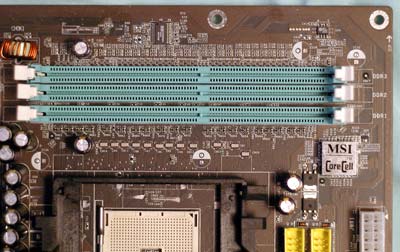
Three DIMM slots support up to 2GB of up to DDR400 memory in a Single-Channel memory configuration. The Athlon 64 will support Dual Channel memory with the introduction of Socket 939. However, as we have discussed in other reviews, the Athlon 64 is not as dependent on memory bandwidth as Pentium 4 solutions. The single-channel socket 754 is just as fast as the dual-channel Athlon 64 FX chips in many applications.










26 Comments
View All Comments
kmmatney - Tuesday, April 27, 2004 - link
Ahhhhhh! A long spiel about how great the board is at overclocking....and then no overlocked benchmarks!! I want to see how much gain you get! How about a single game and encoding benchmark?Pumpkinierre - Monday, April 26, 2004 - link
I agree with #10, Wesley, you should include at least one synthetic with your overclocking tests because you have'nt done any good overclocking/high FSB tests on a64s as you havent had a mobo with good PCI/AGP lock or >250 FSB til now. It makes me wonder why because you are thorough with the p4/i875 and by your own admission the gigabyte and shuttle nF3-150 have PCI/AGP locks and ClockGen adjusts the FSB. The location of the a64 memory controller ondie means the memory sync/async tests results from intel systems cant be translated to the a64 ones. So, in my opinion, for conservative a64 overclockers, benchmark results at the same cpu speed but different FSB (clockspeed) sync or async and HT alteration would be of good use. I know you are just seeing the limits etc. but you must be running stability tests so it costs you nothing in time to throw in the sandra or Memtest86 bandwidths or even 3DMark2001/2003 results.And I agree there is merit in running cool and quiet with overclocked systems(if possible) as the windows software overclockers are still not perfect and only available on some brands.
Jeff7181 - Monday, April 26, 2004 - link
Wesley,It may not really fit in with a motherboard review, but seeing as how it seems overclocks on the nF3 150 and KT800 chipsets have been limited by the motherboard, it makes sense to test the overclocked performance to see if it's worth paying for a motherboard with lower performance at stock speeds that might provide a lot better performance once overclocked. For example, if the nF3 250 can only match KT800 performance after overclocking, it makes the choice much more clear.
cnq - Monday, April 26, 2004 - link
Wesley,Thanks for the quick response. Glad to hear you are considering mixing manual overclocking with cool'n'quiet in future tests.
You mention that "I am not convinced that it matters to most overclockers". I think that's just because c'n'q' is fairly new. If you tell them that c'n'q is just the thing to help prolong the life of their overworked system, they'll start paying attention. Only those who run 100% cpu utilization 24/7/365 won't care.
For the rest of us, mixing Cool'n'Quiet with overclocking makes perfect sense (throttle back the cpu when just web browsing; crank it up to overclocked when you need a burst of bower, which in my case is compiling. Note that I'm not counting MSI's CoreCell auto-overclocking because it's not powerful enough...)
I'd also claim that Cool'n'Quiet is *doubly* useful in a heavily overclocked system. Such systems are often on the ragged edge of overheating, and thus could benefit more than anyone from throttling at times of light or moderate load.
Naturally, when the load jumps back up, we'd want the fully overclocked manual settings to automatically kick back in. And that's the rub. Will that part work?
Has anyone tried running Cool'n'Quiet on a manually overclocked A64? Does it (a) work perfectly, (b) crash, (c) not crash but "forgets" your overclock settings, (d) other? I'm guessing it will crash, esp. if manual overclock settings included changing the CPU voltage or raising the HTT while lowering the CPU multiplier. Hoping to hear I'm wrong (for at least one A64 board) before making purchase...
Schnieds - Monday, April 26, 2004 - link
Do you have any idea when this motherboard will be available for purchase in retail outlets? From the review it sounds like this board is a release version and ready for retail, but no one seems to know when it will actually be available for purchase... Thanks for the great review.Wesley Fink - Monday, April 26, 2004 - link
#7 - nForce3 chipsets automatically control Bank Interleave and Command Rate - there are no manual options. Some VIA chipsets do allow interleave and command rate settings. We always specify the setting we used in the review - if those settings are available. If they are not an available option we state NA for Not Available in our Memory Stress Testing tables. We also always enable interleave if it is an option.#8 - I added Cool'n'Quiet to the Feature list at your suggestion. Most overclockers turn off auto features for overclocking, because frankly I can always out-tweak Auto settings on OC. I will consider doing more with Cool'n'Quiet in overclocking, but I am not convinced it matters much to most overclockers.
#9 - Corrected. Not to be defensive, but if you want to see how much AnandTech found with this board that other sites missed, read through K8N Neo reviews that others have posted.
#10 - What would it take to make you happy on OC results in board reviews? I have explored 1:1 vs aynch in memory reviews. Performance results at a full-range of OC and timings are always a part of memory reviews. What would you like to see in motherboard reviews?
Jeff7181 - Monday, April 26, 2004 - link
No overclocked comparisons? Awwww man... questions still unanswered...KillaKilla - Monday, April 26, 2004 - link
How well did the Albatron GeForce FX5950U work with those ATI Catalyst 4.4 drivers?Not to be sarcastic, but simply alerting those who can correct this to the typo.
cnq - Monday, April 26, 2004 - link
Wesley,You mentioned that you disabled Cool'n'Quiet to prevent possible interference with overclocking.
I wonder if it's even worse than "interference": is it even *possible* to run Cool'n'Quiet on a heavily overclocked system? (especially one with aggressive overclocking: significantly raised HTT with lowered CPU multiplier).
This is one of those things that should be a FAQ, yet no one seems to have tried. Cool'n'Quiet is the perfect complement to an aggressively overclocked system: prolonging its lifespan by giving it a "breather" when just (e.g.) web browsing. But are Cool'n'Quiet and overclocking compatible?
(Pls refer to my same question in your Aopen AK89 Max review for specific technical reasons why I think c'n'q and aggressive overclocking may not be compatible. I hope I'm wrong.)
Myrandex - Monday, April 26, 2004 - link
My K8T Neo supports cool and quiet completely, and toms hardware confirms this too with an older A64 mobo roundup. Looks like a hell of a board, but I am wondering why so many reviews at Atech are run w/ Bank interleave set to disabled. I remember back in the K6/2 days, this was a major bios tweak for memory. Does it not matter, or negatively effect performance now?Jason